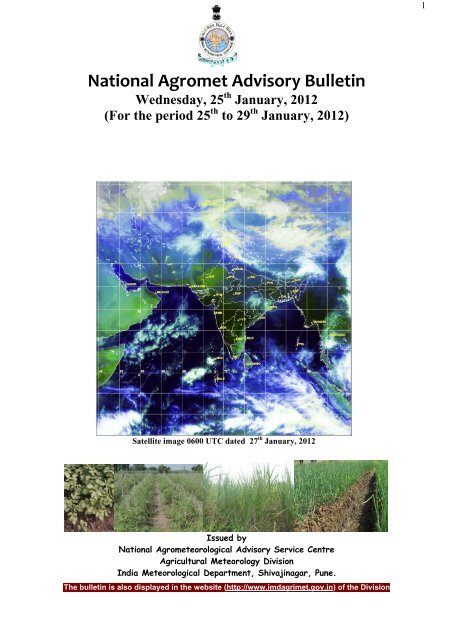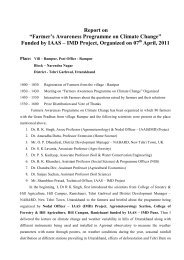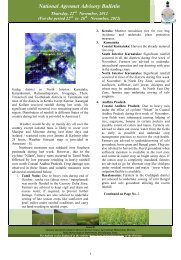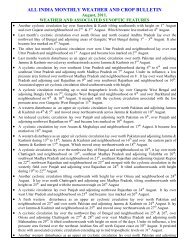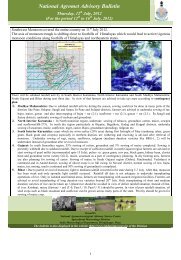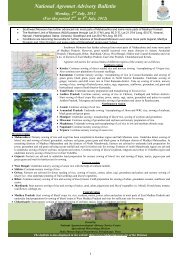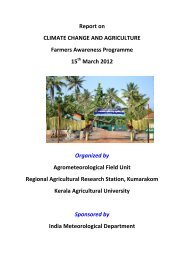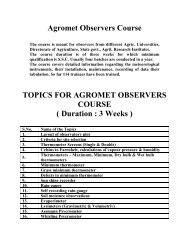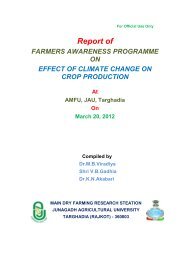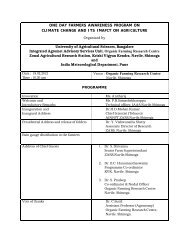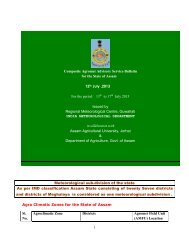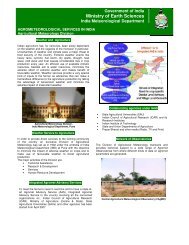Wednesday, January 25, 2012 - Agricultural Meteorology Division
Wednesday, January 25, 2012 - Agricultural Meteorology Division
Wednesday, January 25, 2012 - Agricultural Meteorology Division
Create successful ePaper yourself
Turn your PDF publications into a flip-book with our unique Google optimized e-Paper software.
1<br />
National Agromet Advisory Bulletin<br />
<strong>Wednesday</strong>, <strong>25</strong> th <strong>January</strong>, <strong>2012</strong><br />
(For the period <strong>25</strong> th to 29 th <strong>January</strong>, <strong>2012</strong>)<br />
Satellite image 0600 UTC dated 27 th <strong>January</strong>, <strong>2012</strong><br />
Issued by<br />
National Agrometeorological Advisory Service Centre<br />
<strong>Agricultural</strong> <strong>Meteorology</strong> <strong>Division</strong><br />
India Meteorological Department, Shivajinagar, Pune.<br />
The bulletin is also displayed in the website (http://www.imdagrimet.gov.in) of the <strong>Division</strong>
2<br />
Executive Summary<br />
Minimum temperatures prevailed in the range of 4-6° over many parts of Jammu &<br />
Kashmir, Himachal Pradesh and Punjab. Cold wave along with ground frost conditions<br />
prevailed at a few places over Haryana and in isolated pockets of Punjab, Rajasthan, West<br />
Uttar Pradesh, north Madhya Pradesh and some parts of east India during mid-period of last<br />
week. Also chances of fall in minimum temperatures by 1-2°C over parts of northwest and<br />
east India during next 1-2 days. Farmers are advised to keep vigil and provide light,<br />
frequent irrigation and arrange for smoking around the fields to protect standing crops from<br />
frost / cold injury. However, the prevailing weather conditions are favourable for the growth<br />
of wheat crop in these regions.<br />
Scattered rain / snowfall occurred over Jammu & Kashmir and Himachal Pradesh<br />
during last week. Rain / snowfall is also likely to occur at many places over Jammu &<br />
Kashmir and Himachal Pradesh after 24 hours. Farmers in these States are advised to<br />
postpone irrigation to the standing rabi crops. Mainly dry weather prevailed over most of<br />
the remaining parts of the country and either isolated rainfall or dry / mainly dry weather is<br />
likely to occur. Farmers are advised to provide irrigation to the rabi crops which are at<br />
critical stages (flowering / grain filling).<br />
Farmers are advised to undertake sowing of cucurbitaceous and leafy vegetables in<br />
Madhya Pradesh, sowing of groundnut, moong, urad and maize and planting of onion in<br />
Orissa, land preparation and transplanting of boro rice in West Bengal and Tripura, planting<br />
of sugarcane in Assam, nursery sowing of tomato, brinjal, chilli and sowing of cucurbits in<br />
Jammu & Kashmir, sowing of cumin in Uttar Pradesh and sowing of water melon and<br />
planting of sugarcane in Maharashtra.<br />
Due to favourable weather conditions, incidences of thrips in onion, brinjal and<br />
bhindi in Karnataka, leaf folder and stem borer (white ear) in thaladi rice in Tamil Nadu,<br />
leaf eating caterpillar in gram in Madhya Pradesh, stem borer in rice (nursery) in<br />
Chhattisgarh and pod borer in gram and aphids in rapeseed and mustard in Orissa are<br />
noticed below economic threshold level (ETL). Farmers are advised to undertake<br />
appropriate plant protection measures to control the pests and diseases, if their population<br />
goes beyond ETL.
3<br />
Contour maps for Mean Maximum and Minimum Temperature and their anomaly for<br />
the week ending on <strong>25</strong>.01.<strong>2012</strong><br />
Actual Mean Maximum temperature ranged between 32 0 C and<br />
above over most parts of Lakshadweep Islands, some parts of South<br />
& North Interior Karnataka and Andhra Pradesh, 28 to 32 0 C over<br />
most parts of Maharashtra, South India (except Lakshdweep<br />
Islands), some parts of Orissa, Chattisgarh and Andaman &<br />
Nicobar Islands, 12 to 16 0 C over most parts of Jammu & Kashmir<br />
and Himachal Pradesh, 16 to 20 0 C over most parts of Uttarakhand,<br />
Punjab, Haryana, Delhi and West Uttar Pradesh, some parts of<br />
Rajasthan, 20 and 28 0 C over remaining parts of the country.<br />
Actual Mean Maximum temperature anomaly ranged above 2 0 C<br />
over some parts of Andhra Pradesh, South & North Interior<br />
Karnataka and Lakshadweep Islands, 0 to 2 0 C over most parts of<br />
Marathwada, South India (except Coastal Karnataka), some parts of<br />
Orissa, Chattisgarh, Jharkhand, Madhya Maharashtra and<br />
Vidarbha, -6 to -4 0 C over some parts of East Rajsthan, Gujarat, -4<br />
and 0 0 C over remaining parts of the country.<br />
Actual Mean Minimum Temperature ranged between 20 0 C and<br />
above over most parts of Lakshadweep, Andaman & Nicobar<br />
Islands, 16 to 20 0 C over most parts of Andhra Pradesh, Coastal<br />
Karnataka, Kerala, Tamil Nadu, Andaman & Nicobar Islands, some<br />
parts of Konkan & Goa, South Interior Karnataka and coastal<br />
Orissa, 0 to 4 0 C over most parts of Jammu & Kashmir, Himachal<br />
Pradesh, 4 to 8 0 C over most parts of Uttarakhand, Punjab, Delhi,<br />
Haryana, Rajasthan, Uttar Pradesh, North Madhya Pradesh, some<br />
parts of Gujarat, 8 0 C to 16 0 Cover remaining parts of the country.<br />
Minimum Temperature anomaly ranged between 2 to 4 0 C over<br />
most parts of Lakshadweep Islands, some parts of West Rajasthan,<br />
Manipur, Mizoram, Tripura, Saurashtra & Kutch, Andhra Pradesh,<br />
-2 to 0 0 C over most parts of Haryana, Delhi, West Uttar Pradesh,<br />
East Rajasthan, West Madhya Pradesh, Tamil Nadu, some parts of<br />
Jammu & Kashmir, Uttarakhand, East Uttar Pradesh, Bihar,<br />
Orissa, Chattisgarh, Maharashtra (except Konkan & Goa),<br />
Rayalaseema, North & South Interior Karnataka, Kerala. 0 to<br />
2 0 C over remaining parts of the Country.
4<br />
Distribution of rainfall of the country during week ending on <strong>25</strong>.01.<strong>2012</strong><br />
State/Districts<br />
Actual<br />
(mm)<br />
% Dep.<br />
Arunachal Pradesh<br />
Anjaw 0.0 -100<br />
Changlang 12.5 -1<br />
East Kameng 1.0 -90<br />
East Siang 28.0 460<br />
Lohit 2.0 -78<br />
Lower Subansiri 4.0 -83<br />
Papumpara 4.0 -<strong>25</strong><br />
Tawang 2.0 -81<br />
Tirap 20.6 203<br />
Upper Dibang Valley 66.0 362<br />
Upper Siang 54.0 306<br />
Upper Subansiri 0.0 -100<br />
West Kameng 0.7 -94<br />
Himachal Pradesh<br />
Bilaspur 2.1 -85<br />
Chamba 67.5 140<br />
Hamirpur 5.7 -71<br />
Kangra 13.5 -29<br />
Kinnaur 14.1 -35<br />
Kullu 13.5 2<br />
Lahaul and Spiti 2.3 -94<br />
Mandi 8.7 -48<br />
Shimla 11.6 -27<br />
Sirmaur 0 -100<br />
Solan 0.2 -99<br />
Una 4.4 -61<br />
Jammu & Kashmir<br />
Anantnag 30.9 26<br />
Badgam 9.8 -41<br />
Baramula 7.3 -76<br />
Doda 38 11<br />
Ganderwal 23.4 33<br />
Jammu 0.3 -98<br />
Kargil 4 -69<br />
Kathua 1.1 -94<br />
Kulgam 24.9 1<br />
Kupwara 19.9 -5<br />
Ladakh(Leh) 0.1 -96<br />
Poonch 7 -81<br />
Pulwama 9.2 -32<br />
Rajouri 8.1 -56<br />
Ramban 37.4 10<br />
Reasi 5.2 -81<br />
Samba 1.3 -91<br />
Shopian 20 47<br />
Srinagar 14.5 -18<br />
Udhampur 8.3 -70<br />
(20% or more) excess rainfall (-60 to -99 %) scanty rainfall<br />
(-19 to +19%) normal rainfall (-100%) no rainfall<br />
(-20 to -59% )deficient rainfall ** Data not available
5<br />
Weather Forecast<br />
(Valid upto1430 hours of 28 th <strong>January</strong>, <strong>2012</strong>)<br />
<br />
<br />
<br />
<br />
<br />
<br />
<br />
<br />
Major Feature of Weather Forecast upto 1430 hours IST of 28 th <strong>January</strong>, <strong>2012</strong><br />
Rain/snow would occur at a few places over western Himalayan region during next 24 hours<br />
and at many places thereafter.<br />
Minimum temperatures would rise slightly over parts of northwest India and by 2-3°C over<br />
adjoining central & east India during next 1-2 days.<br />
Maximum temperatures would rise by 2-3°C over central & east India during next 2-3 days.<br />
Rain/thundershowers would occur at one or two places over plains of northwest, central and<br />
east India during next 48 hours and mainly dry weather thereafter.<br />
Rain/thundershowers would occur at one or two places over northeastern states and extreme<br />
south peninsular India.<br />
Rain/thundershowers would occur at one or two places over Andaman & Nicobar Islands<br />
during next 24 hours and at a few places thereafter.<br />
Fog/shallow fog may occur mainly in morning hours over isolated pockets of east and<br />
northeast India.<br />
Weather would be mainly dry over remaining parts of the country.<br />
<br />
No weather warning.<br />
Weather Warning<br />
<br />
<br />
<br />
Weather Outlook up to 1430 hours IST of 30 th <strong>January</strong>, <strong>2012</strong><br />
Rain/snowfall would continue to occur at one or two places over western Himalayan region.<br />
Rain/thundershowers would occur at a few places over Andaman & Nicobar Islands and at<br />
one or two places over northeastern states and central, east & south peninsular India.<br />
Weather would be mainly dry over rest parts of the country.
6<br />
Zonewise Agromet Advisories<br />
NORTHEAST INDIA [ARUNACHAL PRADESH, NMM&T, ASSAM, MEGHALAYA]<br />
Realised Rainfall: No significant rain occurred in most of the districts of the States of the<br />
region except in Upper Dibang Valley and Upper Siang districts of Arunachal Pradesh<br />
during last week.<br />
Rainfall Forecast: Rain / thundershower would occur at isolated places over Arunachal<br />
Pradesh, Assam and Meghalaya and mainly dry weather will prevail over Nagaland,<br />
Manipur, Mizoram and Tripura during the period.<br />
Advisories<br />
‣ As significant rain occurred in Upper Dibang Valley and Upper Siang districts of<br />
Arunachal Pradesh, farmers in these districts are advised to postpone irrigation to the<br />
standing crops. As there was no significant rain during last few weeks in most of the<br />
remaining districts of the States of the region and no significant rain is likely to occur,<br />
farmers are advised to apply irrigation to the standing crops.<br />
‣ Farmers in Assam are advised to continue preparation of nursery bed and transplanting<br />
of boro rice.<br />
‣ Farmers in Hill Zone of Assam are advised to harvest matured bolls of cotton, preferably<br />
in the morning hours to get good quality cotton.<br />
‣ Farmers of Upper Bramhaputra Valley Zone of Assam are advised to continue land<br />
preparation and planting of sugarcane.<br />
‣ Farmers of Lower Bramhaputra Valley Zone of Assam are advised to continue land<br />
preparation and sowing of ahu rice, sugarcane, pointed gourd, musk melon, water melon,<br />
pumpkin etc.<br />
‣ Farmers in Mid Tropical Plain Zone of Tripura are advised to complete sowing of boro<br />
rice in lowland. As dry weather is prevailing during last few weeks and there is less<br />
possibility of significant rainfall, farmers are advised to apply light irrigation to pulse<br />
crops and also to sugarcane.<br />
‣ Farmers in Temperate Sub Alpine Zone of Meghalaya are advised to continue<br />
preparation of nursery bed and transplanting of boro rice. Prepare land for sowing of<br />
ladies finger, pumpkin and French bean.<br />
‣ Farmers of Sub tropical Plain Zone of Manipur are advised to undertake sowing of<br />
cucurbits like water-melon, cucumber and sponge gourd. Undertake land preparation for<br />
sowing of rice and complete land preparation for transplanting of French bean / tomato/<br />
brinjal / chilli.<br />
‣ As there was no significant rain during last few weeks in Mild Tropical Hill Zone of<br />
Mizoram, lack of moisture coupled with present weather conditions caused fruit cracking<br />
in tomato; hence farmers in Mild Tropical Hill Zone of Mizoram are advised to ensure<br />
sufficient moisture.<br />
‣ Suitable varieties of the crops for sowing or transplanting are mentioned in Annexure II.<br />
‣ Due to prevailing weather, there is chance of late blight on tomato at vegetative and<br />
fruiting stage in Hill zone of Assam; farmers are advised to apply Ridomil MZ-72 @ 2 g<br />
/ litre of water and Indofil M-45 @ 2.5 g / litre of water at 15 days interval.<br />
‣ Farmers in North Bank Plain Zone and Upper Bramhaputra Valley Zone of Assam are<br />
advised to monitor potato crop as there is chance of attack of late blight due to congenial<br />
weather; for controlling the late blight of potato, spray Mancozeb 75% a.i. @ 2.5 g / litre<br />
of water at an interval of 12 days.<br />
‣ There is attack of wilt disease and aphids on lentil and lathyrus crops at vegetative stages<br />
in Central Bramhaputra Valley Zone of Assam; farmers are advised to drench the soil<br />
with Bavistin @ 1 ml / litre of water to protect the crop from wilt and apply Malathion
7<br />
50 EC @ 2 ml / litre of water. Present weather condition is congenial for appearance and<br />
spread of late blight disease in potato. Spray Mancozeb 75% a.i. @ 2.5 g / litre of water<br />
against late blight.<br />
‣ Prevailing weather is favourable for the incidence of leaf curl and late blight disease in<br />
tomato and brinjal crops in Mid Tropical Plain Zone of Tripura; spray Rogor @ 2 ml per<br />
liter of water or Monocrotophos @ 3 ml per liter of water or Imidacaloprid @ 2 g per<br />
liter of water to manage the attack at an interval of 15 days. Due to prevailing weather<br />
conditions, there is chance of late blight and early blight diseases in potato. To manage<br />
the attack of blight diseases, spray Indofil M-45 or Ridomil or Mancozeb @ 2 g per litre<br />
of water or Cut Zed @ 2.5 g per litre of water.<br />
‣ In Mild Tropical Hill Zone of Mizoram, due to prevailing weather conditions, there is<br />
chance of infestation of aphids in khasi mandarin; spray Monocrotophos (0.05%) against<br />
aphid attack. Due to prevailing weather, infestation of fruit borer may occur in tomato.<br />
Spray 5% neem seed extract to kill larvae or spray NPV @ <strong>25</strong>0-500 LE / ha with teepol<br />
@ 100 ml.<br />
‣ Due to congenial weather, there is chance of attack of late blight in potato and powdery<br />
mildew in pea in Mild Tropical Hill Zone of Nagaland; farmers are advised to monitor<br />
crops and apply appropriate plant protection measures.<br />
‣ Stages of major crops are mentioned in Annexure I.<br />
Animal Husbandry<br />
‣ Fishery farmers in North Bank Plain Zone and Lower and Central Bramhaputra Valley<br />
Zone of Assam are advised to apply Potash @ 4-5 mg / litre of water, Sukrena WS @ 1<br />
litre per bigha of water against various bacterial diseases. Poultry farmers are advised to<br />
vaccinate poultry against ranikhet disease.<br />
‣ Wet bedding and cold weather are prerequisite for pneumonia; farmers in Arunachal<br />
Pradesh are advised to provide dry bedding material to pig / piglets and deworm pig /<br />
piglets and goat.<br />
‣ Prevailing cold weather is favourable for chances of pneumonia in newly born calves in<br />
Mild Tropical Plain Zone of Tripura; farmers are advised to take special care to avoid<br />
cold weather. Provide warm shed to poultry birds and pigs against cold.<br />
‣ The farmers in Mild Tropical Hill Zone of Mizoram are advised to deworm against<br />
Ascariasis / Malap.<br />
‣ The poultry farmers in Nagaland are advised to vaccinate against bird flue and vaccinate<br />
pig / piglet against swine flu. Vaccinate cattle, buffalo, pig, sheep and goat against FMD.<br />
‣ The poultry farmers in Manipur are advised to vaccinate against IBD / Gumboro disease<br />
and deworm pig / piglet.<br />
EAST INDIA [JHARKHAND, BIHAR, ORISSA, WEST BENGAL &SIKKIM]<br />
Realised Rainfall: Mainly dry weather prevailed over the region during last week.<br />
Rainfall Forecast: Either isolated rain / thundershowers would occur or mainly dry<br />
weather will prevail over the States of the region during the period.<br />
Advisories:<br />
‣ As there was no significant rain during last week over the States of the region and no<br />
significant rain is likely to occur during the period, farmers are advised to apply<br />
irrigation to the standing crops.<br />
‣ Undertake sowing of oilseed crops like summer groundnut in Western Undulating Zone,<br />
East and South Eastern Coastal Plain Zone and North Central Plateau Zone of Orissa.<br />
‣ Farmers in Western Undulating Zone of Orissa are advised to undertake land preparation<br />
for planting of sugarcane. Farmers are also advised to undertake transplanting of summer
8<br />
rice and harvesting of cotton on sunny days. Apply irrigation to mustard wherever the<br />
crops are at seed formation stage.<br />
‣ In view of prevailing dry weather, farmers in North Eastern Plateau Zone of Orissa are<br />
advised to apply irrigation to mustard and sunflower.<br />
‣ Farmers in East and South Eastern Coastal Plain Zone of Orissa are advised to transplant<br />
summer rice. Farmers are also advised to undertake harvesting of sugarcane, sowing of<br />
the crops like summer sunflower and groundnut and transplanting of ragi crop.The<br />
farmers are also advised to give irrigation to rabi sunflower as it is at flowering stage.<br />
‣ Farmers in North central Plateau Zone of Orissa are advised to undertake transplanting of<br />
summer rice and apply irrigation to wheat crop. Taking the advantage of dry weather,<br />
farmers are also advised to undertake inter cultural operation in groundnut and<br />
sunflower, apply irrigation to mustard crop and undertake sowing of early summer<br />
vegetables.<br />
‣ As temperature condition is now congenial for planting of autumn planted sugarcane,<br />
onion and sowing of summer vegetables in North West Plain Zone of Bihar, farmers are<br />
advised to undertake these operations.<br />
‣ As dry weather is prevailing, farmers in the districts of North Bihar are advised to apply<br />
irrigation in wheat and harvest matured tobacco crop.<br />
‣ Apply second irrigation and urea as nutrients in timely sown wheat crop, first irrigation<br />
in late sown wheat crops and undertake intercultural operation to maize crop in South<br />
Bihar Alluvial Zone.<br />
‣ Farmers in Western, Central and North Eastern Plateau Zone of Jharkhand are also<br />
advised to plant / sow onion, African marigold or French marigold and prepare the field<br />
for vegetables like long gourd, round gourd, bitter gourd, sponge gourd, cucumber, water<br />
melon and musk melon.<br />
‣ As dry weather is prevailing, farmers in Central and North Eastern Plateau Zone of<br />
Jharkhand are advised to undertake intercultural operations in timely sown wheat, gram,<br />
green pea and pigeon pea.<br />
‣ Farmers in Old Alluvial Zone of West Bengal are advised to undertake land preparation<br />
and transplanting of seedlings of summer rice. Cover the nursery bed with polythene or<br />
keep 2 to 3 cm stagnant water in the nursery bed especially for the night-time to protect<br />
the seedlings from cold and drain out the water in the morning. Irrigate the nursery bed<br />
regularly.<br />
‣ Farmers in Laterite and Red soil zone of West Bengal are advised to transplant boro rice<br />
seedlings of 4-5 weeks age and maintain 2-3 cm of standing water. Farmers are also<br />
advised to undertake field preparation and sowing of groundnut.<br />
‣ Farmers in New Alluvial Zone of West Bengal are advised to transplant of boro rice and<br />
maintain 5 cm standing water. Apply irrigation to wheat crop.<br />
‣ Farmers in coastal Saline Zone of West Bengal are advised to complete transplanting of<br />
boro rice and chilli and sowing operation of Sunflower.<br />
‣ Suitable varieties of the crops for sowing or transplanting are mentioned in Annexure II.<br />
‣ There are chances of infestation of pod borer in pigeon pea in North West Alluvial Plain<br />
Zone of Bihar; apply Dimethoate 30% @ 1 to 1.5 ml per litre of water. Due to partial<br />
cloudy sky and prevailing temperature condition, aphid infestation may occur in mustard;<br />
spray Metasystox @ 1.0 ml per litre of water.<br />
‣ Due to high relative humidity and low temperature in South Bihar Alluvial Zone,<br />
infestation of late blight may occur in potato and tomato; spray Indofil M-45 @ 2 ml /<br />
litre of water and monitor the crop constantly.<br />
‣ Decreased sunshine hours with variant humidity in South Eastern Plateau Zone of<br />
Jharkhand is congenial for attack of Diamond back moth, aphids and thrips in cole crops
and tomato; hence, spray Dimethoate (30%) @ 1 ml per litre of water to control the<br />
attack. Due to cool and humid weather during morning time, infestation of late blight is<br />
seen in potato; spray Krilaksil or Ridomil MZ @ 1.5 g per litre of water.<br />
‣ Weather is favourable for the attack of late blight in potato in Western Plateau Zone of<br />
Jharkhand; spray fungicide like Mancozeb @ 2.5 g per litre of water, Saaf or Intop @ 2 g<br />
per litre of water or Ridomil @ 1.5 g per litre of water.<br />
‣ Infestation of pod borer has occurred in gram and pea in East and South Eastern Coastal<br />
Plain Zone of Orissa; spray 50 ml Imidacloprid or 400 ml Dimethoate or Metasystox in<br />
200 litres water per acre. Leaf eating caterpillar and leaf miner have been found in rabi<br />
sunflower; spray 400 ml Endosulphan / acre.<br />
‣ Current weather is favourable for infestation of leaf eating caterpillar in groundnut in<br />
East and South Eastern Coastal Plain Zone of Orissa. Apply 10 Kg of 2% Methyl<br />
Parathion dust around the bund. Thrips infestation may be found due to current weather.<br />
Spray 400 ml Dimethoate or 50 ml Imidachloprid in 200 litrewate per acre. The current<br />
temperature may also aggravate the infestation of downy mildew in mustard. Spray 2 g<br />
Redomil-MZ / litre water.<br />
‣ In cauliflower, diamond backed moth infestation has occurred in North Eastern Plateau<br />
Zone of Orissa; spray Cartaf Hydrochloride @ 2 ml / litre water.<br />
‣ Current weather favours the infestation of aphids and leaf eating caterpillars in pulses in<br />
North Eastern Coastal Plain Zone of Orissa; Spray Methyl demeton @ 400 ml per acre to<br />
control these insects. Foggy weather has aggravated the attack of aphids in rapeseed and<br />
mustard. Farmers are advised to spray Imidacloprid @ 0.5 ml / litre or Methyl demeton<br />
@ 2 ml / litre of water.<br />
‣ There is infestation of aphids in mustard in Old Alluvial Zone and Hill Zone of West<br />
Bengal. To control, spray Imidachlorpid @ 1 ml / 5 litres of water or Dimethoate @ 2 ml<br />
/ litre of water at 10-15 days interval. There is also possibility of downy mildew in<br />
cucumber in Terai Zone of West Bengal. To control the disease, spray Mancozeb @ 2 g /<br />
litre or Metalaxyl 8% and Mancozeb 64% @ 1-1.5 g / litre of water.<br />
‣ Current weather is favourable for the attack of late blight in potato in New Alluvial zone<br />
of West Bengal; spray Blitox or Mancozeb @ 2.5 g / litre of water at an interval of 5-7<br />
days.<br />
‣ Due to lower temperature and foggy weather in Terai Zone and Old Alluvial Zone of<br />
West Bengal, potato may be attacked by late blight. To prevent the attack of late blight,<br />
spraying of Mancozeb (2 g / litre of water) and Blitox (4 g / litre of water) alternately at<br />
10-12 days interval by completely wetting the leaves is recommended. If attacked by late<br />
blight, spray the mixture of Metalaxyl 8% and Mancozeb 64% @ 1 to 1 ½ g per litre of<br />
water alternately at 12-15 days interval by completely wetting the leaves.<br />
‣ Stages of major crops are mentioned in Annexure I.<br />
Animal Husbandry<br />
‣ Due to low temperature, calves and kids are susceptible to respiratory infection mostly<br />
pneumonia. Farmers in North Eastern Coastal Plain Zone and North Central Plateau Zone<br />
of Orissa are advised to provide warm and comfortable housing and good ventilation to<br />
animals and birds. Vaccination of FMD (Foot and Mouth Disease) to animals is also<br />
recommended. In case of disease outbreak, strict isolation of affected animals should be<br />
done.<br />
Pisciculture<br />
‣ Weather conditions are favourable for growth of fishes in North Eastern Plateau Zone of<br />
Orissa and Western Plateau Zone of Jharkhand; farmers are advised to add cow dung and<br />
lime in the pond as natural foods for them and alternative feeds may also be used like rice<br />
bran and mustard cake (each of 5 kg per day per acre area of pond).<br />
9
10<br />
‣ Farmers in North Central Plateau Zone and North Eastern Coastal Plain Zone of Orissa<br />
are advised to prevent the EUS disease in fish during winter; apply Cifax @ 400 ml per<br />
pond of 1 acre area and 1 meter depth of water.<br />
NORTHWEST INDIA [JAMMU & KASHMIR, HIMACHAL PRADESH,<br />
UTTARAKHAND, PUNJAB, HARYANA, DELHI, UTTAR PRADESH & RAJASTHAN]<br />
Realised Rainfall: Either no significant rainfall or dry weather prevailed over most states<br />
of the region during last week except in Chamba district in Himachal Pradesh.<br />
Rainfall Forecast: Rain/snow is likely to occur at a few places during next 24 hours and<br />
at many places later on over Jammu & Kashmir and Himachal Pradesh and decrease<br />
thereafter. Mainly dry / dry or isolated rainfall is likely to occur over remaining parts of<br />
the region.<br />
Advisory:<br />
‣ There was no significant rainfall in Jammu & Kashmir and Himachal Pradesh except<br />
Chamba district in Himachal Pradesh. Farmers are advised to apply irrigation to the<br />
standing crops and postpone irrigation in above mentioned district.<br />
‣ Farmers in New Delhi are advised to give light irrigation at evening in tomato, chilli,<br />
capsicum, marigold, peas, gram and other field crops to protect the crops from possible<br />
cold injury. In timely sown wheat crop, second irrigation may be given. Farmers are also<br />
advised to transplant onion, late cauliflower (snowball), cabbage and knolkhol, sowing of<br />
spinach, prepare nursery bed for chilli, tomato and brinjal crops and seedling of early<br />
cucurbitaceous crops in poly house.<br />
‣ Farmers in Punjab are advised to give light irrigation to the standing crop at flowering<br />
stage to protect it from cold and also damage of horticultural and vegetable crops.<br />
‣ Farmers in Central Plain Zone of Punjab, are advised to apply second irrigation to wheat<br />
sown during November and first irrigation to wheat sown during December. To late sown<br />
wheat, apply second dose of N with first irrigation. For controlling Gulli Danda a new<br />
herbicide Axial (Pinoxadon 5 EC) at 400 ml g/acre can be used.<br />
‣ In Sub Tropical Zone of Jammu and Kashmir, farmers are advised to undertake nursery<br />
sowing of tomato, brinjal, chilli crop, harvesting of citrus fruits and raise cucurbits under<br />
protection in polythene bags. Due to decrease in minimum temperature, they are advised<br />
to protect the mustard crop from frost by burning farm waste for creating smoke around<br />
the field and also to protect young evergreen plants by providing with thatches prepared<br />
from Sarkanda or any other material and to keep open on eastern side to allow sufficient<br />
sun shine and air for the plant. Farmers can plan for plantation of new orchards during<br />
these days. Due to previous and further chances of rainfall, farmers are advised to not<br />
allow stagnating water in wheat, barley, mustard and gobhi sarson field under low laying<br />
area areas.<br />
‣ In Valley Temperate zone of Srinagar, wheat, brown sarson, pea, lentil, oat are in<br />
dormant stage, farmers are advised to stop all agronomic activities in the field. Farmers<br />
are also advised to maintain orchard sanitation and in case of heavy rainfall / snow,<br />
drainage channels should be dug so as to avoid water stagnation. Farmers are advised to<br />
complete transplanting of onion, planting of garlic, sowing of leafy vegetables (orach,<br />
spinach and methi) in poly house. Also advised to mulch seed crops of Knol Khol,<br />
cabbage and root crops, stop pruning activities in fruit crops and not to go for new<br />
planting.<br />
‣ In Intermediate Zone of Jammu & Kashmir, farmers are advised to raise cucurbits under<br />
protection in polythene bags, nursery sowing of tomato and brinjal, transplanting of<br />
onion, knolkhol.
‣ Farmers in Leh region are advised to harvest Chinese cabbage, lettuce, beet leaf var.<br />
Mongol at weekly interval. It is advised to clear the snow from the poly houses and<br />
trenches to avoid excessive weight on the UV film and cover the polythene of green<br />
houses with black polythene in the night for proper growth of crops. They are also<br />
advised to give one light irrigation to garlic crop germinated in the low tunnel during day<br />
time.<br />
‣ In High Hill Temperate Dry Zone of Himachal Pradesh, treat the apple plants damaged<br />
by snow with chowbatia paste / fungicides and remove heavy snow from branches<br />
particularly in orchards where pruning is yet to be done. Farmers are also advised to<br />
prepare pits for planting new plants.<br />
‣ In Uttar Pradesh, farmers are advised to complete sowing of cumin. Continue cutting of<br />
berseem (fodder), digging of matured carrot, raddish, turnip and harvesting of early<br />
maturing arhar.<br />
‣ Farmers in Uttar Pradesh are advised to give light irrigation in normal wheat, rabi pulses,<br />
rabi oilseeds, sugarcane, potato, already transplanted vegetable crops to protect from low<br />
temperature/frost injury. Also advised to go for topdressing of Urea for enhancing the<br />
growth of rajmaha and other crops.<br />
‣ Prevailing weather condition are favourable for yellow rust in wheat (rust susceptible<br />
varieties) in Sub Tropical Zone of Jammu & Kashmir, under such condition farmers are<br />
advised to spray the crop with propiconazole (Tilt) @ 0.1 or mancozeb @ 0.2% at disease<br />
appearance and repeat after 30-35 days intervals. There are also chances of increase in<br />
early & normal sown mustard crop under this situation farmers are advised to spray the<br />
crop with Chloropyriphos @ 0.05% or Metasystox @ 0.03% when 40-45% plants are<br />
infested with aphid.<br />
‣ In Bhabar and Tarai, sub-humid sub tropic zones of Uttarakhand, due to last week rainfall<br />
and snowfall, there has been sufficient moisture in soil, and weather during this week will<br />
remain dry, hence farmers are advised to top dress Urea @ one kg per Nali to boost the<br />
ear head emergence of wheat crops. Also if there is deficit of moisture in soil then,<br />
farmers are advised to give irrigation in early sown nursery of Tomato, Capsicum, Onion<br />
& other vegetable crops like coriander, spinach, radish, menthe, if irrigation facilities are<br />
not available, then put straw mulch in between rows for moisture conservation..<br />
Continue digging of late planted potato crop.<br />
‣ In sub-humid sub tropic zones of Uttarakhand, farmers are advised to control fruit borers<br />
in tomato and brinjal apply DDVP 76 EC or Malathion 50EC @ 750ml and 2litres<br />
respectively in 600-800litres of water.<br />
‣ In Western Zone of Punjab farmers are advised to spray <strong>25</strong>0 g Blitox or Indofil M 45 in<br />
100 litres of water per acre for the control of alternaria blight/ downy mildew/ white rust<br />
in oilseeds. For avoiding aphid attack in raya spray the crop with 40 Actara <strong>25</strong> WG or<br />
Rogor 30 EC or 600 ml of Dursban 20 EC in 80-1<strong>25</strong> litres of water per acre or apply 4 kg<br />
Thimet 10 G (Phorate) or 13 kg Furadan 3 G followed by light irrigation.<br />
‣ In Delhi, in present weather condition, constant monitoring of wheat crop against attack<br />
of yellow rust is advised. If symptom is found spraying of Propiconazole <strong>25</strong> EC (Tilt <strong>25</strong><br />
EC) @0.1 % is recommended to check its further spread. This treatment also provides<br />
protection against Powdery mildew and Karnal bunt disease, beside rust.<br />
‣ Due to cloudy weather in past week, mustard crop may be affected with aphid insect<br />
attack in Transitional Plain Zone of Inland Drainage zone of Rajasthan. Farmers are<br />
advised to dust methyl parathion 2% @ <strong>25</strong> kg per hectare or spray Methyl Demeton <strong>25</strong><br />
EC per litre water where facility of water exists. Repeat spray if problem persists. Spray<br />
after clearing of weather.<br />
‣ Stages of major crops are mentioned in Annexure I.<br />
11
12<br />
Animal Husbandry<br />
‣ In Himachal Pradesh, in view of falling night temperature, it is advised to protect newly<br />
born calves from the cold as weather is conducive for white scour, naval ill and<br />
pneumonia. Ensure cleanliness in cows having advanced pregnancy to avoid mastitis and<br />
Feed pregnant and lactating cows and buffallos with balance feed including mineral<br />
mixture.<br />
‣ In Semi-Arid Eastern Plain Zone of Rajasthan, it is advised to protect milch and infant<br />
animals from cold, cover the door of animal house and wrap jute bag around animal back<br />
and keep litter dry everyday.<br />
‣ Newly born calves need special care during cold weather as they are susceptible to attack<br />
of pneumonia. Keep them warm by providing clean & dry bedding in Punjab and<br />
Haryana.<br />
‣ Farmers in Bundelkhand zone and in western plain zone in Uttar Pradesh are advised to<br />
tie young cattle in closed shelter and feed them with big cardamom, ajwain and jaggery,<br />
keep cattle shelter clean and take special care of young ones to protect from cold in this<br />
season.<br />
SOUTH INDIA [TN, AP, KERALA, KARNATAKA, LAKSHADWEEP, ANDAMAN &<br />
NICOBAR ISLANDS]<br />
Realised Rainfall: No significant rainfall occurred in most states of the region.<br />
Rainfall Forecast: Rain/thundershowers would occur at one or two places over extreme<br />
south peninsular India. Rain/thundershowers would occur at one or two places over Tamil<br />
Nadu and Kerala during next three days.<br />
Advisories:<br />
‣ As no significant rainfall occurred in most states of the region, apply irrigation to the<br />
standing crops.<br />
‣ Farmers in the Eastern Dry Zone of Karnataka are advised to continue harvesting and<br />
threshing of paddy and finger-millet, since there is no rain for next five days as per the<br />
forecast. In areas where the paddy harvesting is completed, farmers are advised to take up<br />
the sowing of pulses like black gram and green gram.<br />
‣ Farmers in the North Dry Zone of Karnataka are advised to continue sowing of<br />
groundnut and transplanting of onion under irrigated conditions and complete harvesting<br />
of chickpea, sorghum and safflower and take up picking of byadagi chilli and cotton,<br />
since clear sky with bright sunshine is forecasted during the next five days.<br />
‣ Farmers in the Hill Zone of Karnataka are advised to take up plant protection measures,<br />
since there is no possibility of rainfall in the district during the coming five days.<br />
‣ Farmers in the South Zone of Tamil Nadu are advised to harvest the rice crop that<br />
attained maturity, avoid threshing rice on stone blocks and use mechanical thresher, dry<br />
rice seeds to 9% moisture content and mix captan at 4 g/kg of seeds for long term<br />
storage, plant sugar-cane and irrigate the crops, since dry weather is expected in the<br />
coming days.<br />
‣ Farmers in the Problem Area Zone of Kerala are advised to harvest sugarcane crop when<br />
it is fully mature because delayed harvesting will reduce the yield of jaggery, undertake<br />
land preparation for the next crop and planting has to be done within <strong>January</strong>. They are<br />
also advised to prune the excessive vegetative growth in cowpea and plant vegetables.<br />
‣ Farmers in the North Eastern Zone of Tamil Nadu are advised to drain out excess water<br />
in the paddy field, undertake propping of three or four mature paddy crops to avoid<br />
germination in the field itself, drain excess water in case of vegetative paddy crops and<br />
apply top dressing with nitrogen and potassium fertilizers to facilitate the recovery of<br />
crops and undertake weeding operation in groundnut crops. They are also advised to
13<br />
provide adequate facilities to drain water from sugarcane crops, trop the lodged<br />
sugarcane crops in order to avoid damage caused by water logging and provide support to<br />
partially fallen banana trees.<br />
‣ Incidences of leaf folder and stem borer (white ear) are being noticed in thaladi rice in the<br />
Cauvery Delta Zone of Tamil Nadu. Farmers are advised to apply cartop hydrochloride 4<br />
G @ 6 kg with sand or choloriphyriphos 400 ml/ac to control them.<br />
‣ Farmers in the Western Zone of Tamil Nadu are advised to take proper plant protection<br />
measures for managing leaf folder incidence and false smut disease and blast disease in<br />
paddy.<br />
‣ Farmers in the South Zone of Tamil Nadu are advised to monitor leaf hopper in cotton<br />
and spray imdachloprid 100 ml / ha and neem oil 3 % thrice at 15 days interval if<br />
incidence is severe.<br />
‣ Farmers in the High Altitude Hilly Zone of Tamil Nadu are advised to monitor mites<br />
infestation in tea and adopt suitable mulching measures to avoid frost damage.<br />
‣ Farmers in the Southern Telangana Zone of Andhra Pradesh are advised to monitor leaf<br />
folder in paddy, thrips and leaf miner in groundnut, stem borer in maize, powdery mildew<br />
in coriander, gourds and bhendi, aphids in beans, powdery mildew and gemini virus in<br />
chillies, leaf miner and canker in sweet orange, hoppers, powdery mildew and<br />
anthracnose in mango and powdery mildew and downy mildew in grapes and undertake<br />
plant protection measures.<br />
‣ Farmers in the Krishna Godavari Zone of Andhra Pradesh are advised to undertake plant<br />
protection measures, since present weather conditions are conducive for seedling rot,<br />
bacteria leaf spot and canophora blight in chilli, powdery mildew, cercospora and leaf<br />
spot in rabi pulses, smut disease in paddy, sucking pest, kamma rogam, rust and blight<br />
in rice fallow maize.(repeated)<br />
‣ Farmers in the High Altitude Zone of Kerala are advised to irrigate the crops as dry<br />
weather is expected in the coming week and also select short-medium duration varieties<br />
for summer paddy crop.<br />
‣ Thrips activity is increased in vegetables like onion/brinjal/bhendi in the North Dry Zone<br />
of Karnataka, due to continuous dry weather. Farmers are advised to spray oxydemeton<br />
methyl (1.5 ml) or dimethoate (1.7 ml) with one liter of water and use sufficient quantity<br />
of spray mixture, so that whole the canopy can be covered to control them.<br />
Animal Husbandry:<br />
‣ Farmers in the North East Dry Zone of Karnataka are advised to vaccinate the animals<br />
against Foot and Mouth disease, as there are reports of incidences of the disease.<br />
‣ Farmers in the North Western Zone of Tamil Nadu are requested to adopt strict<br />
biosecurity measures for Tracheitis infection in birds, as there were reports of infection.<br />
WEST INDIA [GOA, MAHARASHTRA, GUJARAT]<br />
Realised Rainfall: Dry weather prevailed over the region during last week.<br />
Rainfall Forecast: Dry weather is likely to prevail over the States of the region during the<br />
period.<br />
Advisories:<br />
‣ As dry weather prevailed over the States of the region during last few weeks and dry<br />
weather is also likely to prevail during the period, farmers are advised to apply irrigation<br />
to the standing crops.<br />
‣ Taking the advantage of dry weather, farmers are advised to continue harvesting of<br />
already matured tur in Madhya Maharashtra, Marathwada and Vidarbha and sugarcane in<br />
Madhya Maharashtra and Marathwada.
14<br />
‣ Under prevailing weather farmers of Madhya Maharashtra and Marathwada are advised<br />
undertake planting of sugarcane (Suru).<br />
‣ Prevailing weather is favourable for planting of water melon in Pune division.<br />
‣ In view of prevailing dry weather, farmers of South Konkan and East Vidarbha are<br />
advised to apply irrigation to maintain 2 to 3 cm water level for first 8 to 10 days and<br />
accordingly increase up to 5 cm in transplanted rice field.<br />
‣ Under prevailing weather farmers are advised to complete preparatory tillage and<br />
undertake sowing of summer groundnut in Madhya Maharashtra, Marathwada and west<br />
Vidarbha. Sowing of erect variety may be done at 30 x 10 cm distance, semi-spreading<br />
variety at 30 x15 cm and spreading variety at 45 x15 cm spacing.<br />
‣ Farmers in South Saurashtra Zone of Gujarat State are advised to prepare land for<br />
summer crops like groundnut, moong and pearl millet. Apply irrigation to wheat,<br />
chickpea / gram, castor and garlic.<br />
‣ Farmers in Bhal and Coastal Zone are advised to carry out picking of capsules in castor<br />
during early morning hours. Apply irrigation in mustard crop during pod development<br />
stage.<br />
‣ Farmers in South Gujarat Heavy Rainfall Zone are advised to apply irrigation in<br />
orchards, castor and gram. Taking advantage of dry weather, carry out hand weeding and<br />
other intercultural operations in crops.<br />
‣ Farmers in North Gujarat Zone are advised to apply light irrigation in gram, wheat,<br />
castor, mustard and vegetables. Apply supplementary dose of Nitrogen @ 15 kg N / ha to<br />
isabgol at 30 DAS. Harvest fully matured panicles in castor. Carry out the hand weeding<br />
and intercultural operations in vegetable crops. Cut inflorescences of young mango plants<br />
(less than 3 years) for better vegetative growth. Pluck fully matured fruits of papaya, ber,<br />
guava, pomegranate and citrus fruits. Harvest the maize crop at tasseling stage for fodder<br />
purpose.<br />
‣ Farmers in North West Zone of Gujarat are advised to apply light irrigation to cumin<br />
crop.<br />
‣ Suitable varieties of the crops for sowing are mentioned in Annexure II.<br />
‣ Due to cold and dry weather, infestation of rust in pea and bean may increase in Pune<br />
region; spray Tubeconazole @ 12 ml per 10 litres of water. Second spraying may be done<br />
after 10 to 12 days.<br />
‣ Under prevailing weather there is chance of infestation of rust in wheat in western<br />
Maharashtra scarcity zone; spray Mancozeb 75% @ 1500 g / ha in 500 litres of water<br />
with 10 kg Urea.<br />
‣ As weather condition is congenial, there may be attack of pod borer in gram in<br />
Marathwada; spray Imamectin Benzoate @ 3 g or Heliokil @ 20 ml in 10 litres water.<br />
‣ Due to favourable condition, there may be incidence of anthracnose on new vegetative<br />
flush and inflorescence of mango in South Konkan; spray Carbendazim @ 10 g or<br />
Thiophenate methyl @ 10 g or Propineb @ 20 g per 10 litres of water. There is huge<br />
amount of flowering in Cashew trees and there is also possibility of incidence of tea<br />
mosquito bug in cashew at flowering stage; spray 35 % Profenophos @ 10 ml per 10<br />
litres of water.<br />
‣ Stages of major crops are mentioned in Annexure I.<br />
Animal Husbandry:<br />
‣ Give dry fodder to poultry birds in Middle Gujarat Zone and in South Gujarat Heavy<br />
Rainfall Zone to maintain body heat during cold period. Put curtains to protect poultry<br />
from chill injury.
15<br />
‣ In North West Zone of Gujarat udder of milking animals must be properly cleaned with<br />
insecticide or Zinc Oxide. The beaks of birds in the poultry under the age of 15 Weeks<br />
should be cut. Rats in the poultry should be destroyed. Provide warm water to lactating<br />
animals in North Gujarat Zone.<br />
CENTRAL INDIA [M.P., CHHATTISGARH]<br />
Realised Rainfall: Sky remain mainly clear over the region.<br />
Rainfall Forecast: Possibility of dry weather and clear sky condition over the region.<br />
Advisories:<br />
‣ There is a possibility of clear and dry weather conditions during next 5 days hence<br />
farmers in Bundelkhand region of Madhya Pradesh are advised to give irrigation in<br />
wheat, gram, lentil and all vegetable crops.<br />
‣ Farmers in Kymore Plateau and Satpura Hills region of Madhya Pradesh are advised to<br />
undertake sowing of cucurbitaceous crops, also sow leafy vegetables and prepare land<br />
for summer vegetables.<br />
‣ Farmers in Jhabua Hills region of Madhya Pradesh are advised to give third irrigation in<br />
fully irrigated wheat and maize crops 55-60 DAS, also give recommended dose of<br />
fertilizer. They are also advised to arrange seed of summer vegetables i.e. cucurbit<br />
family, water melon, musk melon, okra, cilli, tomato, brinjal etc. and when temperature<br />
increase and fallow field available then sown these crops.<br />
‣ Due to dry weather forecast farmers in Nimar Valley region of Madhya Pradesh are<br />
advised to irrigate wheat and gram crop; also start planting of sugarcane and prepare<br />
nursery of chilli, brinjal and tomato.<br />
‣ In view of dry weather conditions and low minimum temperature farmers in Central<br />
Narmada Zone of Madhya Pradesh are advised to irrigate the crops. Farmers are also<br />
advised to do for intercultural operations and irrigation in Lentil and Linseed. They are<br />
also advised to irrigate wheat crop.<br />
‣ Present weather conditions are favourable for planting of onion during this week in<br />
Chattisgarh Plain Zone hence it is advised to complete the planting of onion seedlings.<br />
‣ Inter-culture, fertilizer application, earthing followed by irrigation is advised in sugarcane crop<br />
wherever the crop is at knee height stage. Also, where the crop is at knee height stage<br />
farmers are advised for topdressing of nitrogen followed by earthing and irrigation in<br />
Chattisgarh Plain Zone.<br />
‣ At present wheat is at CRI / tillering stage in Chattisgarh Plain Zone and these stages are<br />
critical for moisture stress hence it is advised to irrigate the crop and apply N at CRI<br />
stage.<br />
‣ Farmers in Bastar Plateau Zone of Chhatisgarh are advised to complete sugarcane<br />
planting at the earliest and earlier planted sugarcane should be irrigated. Summer crop<br />
seeds like moong, urad and maize crops of high yielding varieties should be selected and sowing<br />
should be done.<br />
‣ Farmers in Bundelkhand region of Madhya Pradesh are advised that wheat crop are<br />
damaged due to root aphid, for its control apply the recommended dose of insecticide i.e.<br />
phorate 10 G @ 04 kg per acre mix with sand after irrigation, also stem borer are<br />
damaging the wheat crop, for the control use insecticide trizophos 40 EC @ 2.0 ml/liter<br />
of water.<br />
‣ Chickpea crop is being damaged by the caterpillar in Central Narmada region of Madhya<br />
Pradesh so farmers are advised to monitor the chickpea crop and when pest reaches at<br />
ETL level the spray of quinalphos 20E.C @ 2.0 ml. per liter of water is recommended.<br />
‣ Due to cloudy conditions powdery mildew attack can be there in the crops like lathyrus<br />
and lentil in Bastar Plateau Zone of Chhatisgarh. For its control any sulphur based
16<br />
fungicide can be used. In the safflower and mustard crop, the attack of aphids is being<br />
observed. For its control, Methyl dematon should be sprayed @ 1 ml/ litre of water.<br />
‣ Incidence of stem borer is seen in the nursery of summer rice in Chattisgarh Plain Zone.<br />
Hence the farmers are advised to use light trap to control it. In case of heavy infestation<br />
of stem borer, apply Carbofuron @ 33 kg/ha.<br />
‣ Due to cloudy weather condition prevailed during first fortnight of <strong>January</strong> aphids in<br />
vegetables and mustard, fruit and shoot borer in brinjal and thrips in groundnut may<br />
occur in Chattisgarh Plain Zone. Hence, farmers are advised to keep keen watch over the<br />
crops and adopt integrated pest management practices like light trap, pheromone trap,<br />
bird prech etc. for initial control. If necessary spray Polytrin C @ 1 litre/ha or<br />
Metasystox @ 2 ml/liter water solution followed by spraying of Dimethioate @ 2ml/liter<br />
water solution after 15 days of first spraying is advised.<br />
‣ Animal Husbandry & Poultry<br />
‣ Farmers in Bundelkhand region are advised that there is possibility of decrease in disease<br />
resistance in chicken; therefore antibiotic may be added in their feed. Also there is<br />
possibility of clear sky conditions during next 5 days, hence sheep raiser are advised to<br />
do medicine bath in sunny condition to control parasites.<br />
‣ Farmers in Jhabua hills region of Madhya Pradesh are advised to vaccinate their animals<br />
to FMD, BQ, and HS via Raksha Triback vaccine. For control of Ranikhet disease in<br />
chicks vaccinate with F-1 or Lasota or R2B Strain vaccine.
17<br />
Annexure I<br />
Major Crops<br />
NORTHEAST INDIA [ARUNACHAL PRADESH, NMM&T, ASSAM, MEGHALAYA]<br />
‣ Sugarcane (old) (harvesting), sugarcane (new) (land preparation / planting), boro rice<br />
(transplanting / seedling / tillering), ahu rice (sowing), wheat (tillering / vegetative / ear<br />
head), tomato, brinjal, country bean (vegetative / flowering / fruiting), cauliflower,<br />
cabbage, knoll khol (vegetative / head formation/ harvesting), rabi pulses like pea, lentil<br />
(flowering / pod formation), onion (vegetative), khasi mandarin (fruit maturity /<br />
harvesting), potato (stolon formation / tuber development / harvesting), rapeseed and<br />
mustard (flowering / siliqua formation / seed formation), rabi maize (vegetative), okra,<br />
pointed gourd, musk melon,water melon,pumpkin,sunflower, ridge gourd,sponge gourd<br />
(sowing) in Assam.<br />
‣ Cabbage, cauliflower, knolkhol etc. (vegetative / head formation/ maturity / harvesting),<br />
maize (tasseling / silking / cob formation / harvesting), mustard (flowering/ pod<br />
formation), potato (tuber formation / harvesting) and pea (pod formation / maturity /<br />
harvesting), turmetric, ginger (maturity) in Arunachal Pradesh.<br />
‣ Rice (sowing), cucurbits (sowing / transplanting), rapeseed / mustard (flowering / siliqua<br />
formation), tomato / brinjal / chilli (transplanting), potato (tuber formation), cauliflower<br />
and cabbage (head formation / maturity), pea (flowering / fruiting / harvesting), rabi<br />
maize as inter-crop (vegetative) in Manipur.<br />
‣ Bororice (tillering / panicle initiation), wheat (tillering / ear initiation), garlic and lettuce<br />
(seedling / vegetative), toria, mustard, rapeseed (siliqua formation / maturity), potato<br />
(tuber formation), Khasi mandarin (flowering / fruiting), lentil, Bengal gram, pea<br />
(flowering / pod formation), rabi onion (vegetative / bulb formation), cashew, apricot<br />
(planting / vegetative / maturity), cabbage and knol-khol (head formation / maturity) in<br />
Meghalaya.<br />
‣ Ginger and turmeric (rhizome formation / maturity / harvesting), khasi mandarin<br />
(vegetative / fruiting / harvesting), banana (vegetative / fruiting / maturity / harvesting),<br />
cole crops (head formation / harvesting), tomato (vegetative / flowering / fruiting /<br />
harvesting), pea, bean (pod formation / harvesting), maize (tasseling / silking / cob<br />
formation) in Mizoram.<br />
‣ Cabbage and broccoli (vegetative / head formation), pea (pod formation / harvesting),<br />
rapeseed, mustard (siliqua formation), French bean (flowering / pod formation), potato<br />
(vegetative / tuber initiation), brinjal (flowering / fruiting / harvesting) and maize<br />
(tasseling / silking / cob formation) in Nagaland.<br />
‣ Boro rice (tillering), pulse crop – pea, beans (vegetative / flowering / pod formation),<br />
ginger and turmeric (rhizome formation / harvesting), mustard (siliqua formation),<br />
tomato (flowering / fruiting), cucurbits and other vegetables (flowering / fruiting), potato<br />
(tuber formation), banana (vegetative / flowering / fruiting) in Tripura.<br />
EAST INDIA [JHARKHAND, BIHAR, ORISSA, WEST BENGAL &SIKKIM]<br />
‣ Sugarcane (vegetative), lobia for green fodder (vegetative), mishrikand (vegetative),<br />
onion, radish (vegetative), cauliflower, cabbage (vegetative / head formation), pigeon pea<br />
(seed formation / maturity), fruit trees (transplanting), potato, sweet potato (tuber<br />
formation), rapeseed, mustard (pod formation / seed formation), wheat (tillering /<br />
booting), vegetables (vegetative / flowering / fruiting), maize (tasseling / silking / cob<br />
formation, pulses (pod formation), sugarcane, onion (planting) in Bihar.
18<br />
‣ Pigeon pea (pod formation / seed formation), turmeric and ginger (vegetative / rhizome<br />
formation), elephant foot yam (tuber elongation), potato (tuber formation / maturity),<br />
sweet potato (stem elongation / tuber elongation / maturity / harvesting), mustard (siliqua<br />
formation / seed formation), linseed (pod formation / seed formation), toria (seed<br />
formation / maturity), green pea (pod formation), cauliflower, cabbage (head formation /<br />
maturity), chilli, tomato (vegetative / flowering / fruiting / harvesting), wheat (tillering),<br />
papaya (transplanting), gram (flowering / pod formation), onion, African or French<br />
marigold (sowing / vegetative) in Jharkhand.<br />
‣ Summer rice (transplanting), summer groundnut, sunflower (land preparation / sowing),<br />
arhar (seed formation / maturity), mustard (pod formation / seed formation), sugarcane<br />
(maturity / harvesting), sugarcane (new) (planting), Bengal gram, lentil, linseed, green<br />
pea (pod formation / seed formation), wheat (tillering), banana and marigold (vegetative),<br />
potato (tuber formation / maturity), tomato (flowering / fruiting), cauliflower, cabbage,<br />
knol-khol (head formation / maturity), onion (vegetative) in Orissa.<br />
‣ Boro rice (transplanting), winter vegetables (vegetative / flowering / fruiting), mustard<br />
(siliqua development / seed formation), wheat (tillering), lentil, gram, sunflower<br />
(flowering / pod formation / seed formation), potato (tuber formation), chilli (flowering /<br />
fruiting) in West Bengal.<br />
‣ Rabi vegetables (fruiting / harvesting), orange (harvesting), ginger (harvesting), wheat<br />
(tillering / flowering), mustard (flowering / siliqua formation), rabi potato (tuber<br />
formation) in Sikkim.<br />
NORTHWEST INDIA [JAMMU & KASHMIR, HIMACHAL PRADESH,<br />
UTTARAKHAND, PUNJAB, HARYANA, DELHI, UTTAR PRADESH & RAJASTHAN]<br />
‣ Wheat (tillering), mustard (siliqua formation), sugarcane (planting), rabi onion<br />
(transplanting), cauliflower, cabbage, broccoli, knolkhol (vegetative / fruiting), carrot, turnip,<br />
early sown tomato radish, spinach and coriander (vegetative/fruiting), pea, gram (flowering /<br />
pod formation), Chilli, tomato, brinjal, cucurbits (nursery preparation in polyhouse) in Delhi.<br />
‣ Wheat (emergence/ early vegetative/ vegetative), vegetables (bhindi, cucurbits), potato<br />
(sowing), mirch, brinjal (nursery sowing in polyhouses), Khira, summer squash, bitter<br />
gourd, tur, brinjal, Shimla mirch, and tomato (sowing / transplanting), Apple and other<br />
temperate fruits (dormant stage in High Hill Temperate Dry Zone), arbi, amaranthus,<br />
turmeric, rice, maize, barley, radish, onion, pea, garlic, coriander, cabbage, knol khol,<br />
parsley, lettuce, fennel, cauliflower, broccoli (sowing / planting) in Himachal Pradesh.<br />
‣ Very late sown Wheat (sowing / emergence), early/normal sown wheat (CRI stage /<br />
vegetative), early/normal sown barley (jointing / tillering), late sown barley (CRI stage),<br />
onion (transplanting), winter vegetable crops viz. potato, radish, carrot, turnip, garlic,<br />
spinach, methi, onion (sowing / transplanting / vegetative / fruiting etc. ), cole crops viz.<br />
early cauliflower, cabbage, knoll khol, broccoli (vegetative), rabi oilseeds i.e. gobi<br />
sarson(bud formation), mustard (pod formation/ reproductive stage), late sown mustard<br />
(flowering), brown sarson (rosette stage), rabi pulses i.e. lentil, gram, pea (vegetative)],<br />
fodder crops like oats (vetetative (2 nd cut)), berseem (vegetative), Horticultural crops viz.<br />
[Apricot, Apple (nursery sowing), orange & guava (fruiting), citrus fruits (harvesting)] in<br />
Jammu & Kashmir. Wheat, Brown Sarson, pea, lentil and Oat are in dormant stage in<br />
Srinagar.<br />
‣ Chilli, capsicum, cauliflower, broccolli (transplanting/seedling), sugarcane (planting),<br />
litchi, loquat, peach, citrus (flowering / fruiting), mango (early varieties) (flowering),<br />
foxtail millet, okhra, bottle gourd, bitter gourd, ginger, turmeric (germination /<br />
vegetative), mustard (Siliqua formation), toria (harvesting), papaya (planting), sorghum,<br />
pigeon pea (vegetative), urd and pearl millets (germination/ early vegetative), potato
19<br />
(maturity / digging), barley, sarson (germination/ vegetative), fodder barseem,<br />
(vegetative/ 1 st cutting), onion (transplanting/germination), wheat (late tillering/ear head<br />
emergence), lentil (sowing) in Uttarakhand.<br />
‣ Wheat (crown root initiation/ vegetative growth), winter sugarcane (vegetative growth),<br />
cucurbits like gourd, bitter gourd, cucumber, etc. and other vegetables like lady’s finger,<br />
tomato, brinjal, chilli, bhindi etc. (vegetative / flowering / fruiting), coriander<br />
(vegetative), cabbage, garlic, cauliflower (fruiting / maturity/ harvesting), onion<br />
(transplanting / vegetative growth), rai /mustard/ sarson (flowering / siliqua formation),<br />
barley (vegetative / tillering), jai, gram, alsi, maize, masoor, pea, pigeon pea, chick pea<br />
(vegetative growth / flower initiation), berseem (vegetative growth / 1 st cutting), potato<br />
(tuber formation / harvesting) in Uttar Pradesh.<br />
‣ Spring sugarcane (sprouting), berseem (vegetative), autumn sugarcane (tillering), gram,<br />
lentil, barley, mustard, rape seed (branching/flowering), radish, carrot, turnip, onion,<br />
cauliflower (transplanting/vegetative), barley / wheat (CRI/tillering - timely sown) in Punjab.<br />
‣ Sugarcane (spring season) (early vegetative), barseem (vegetative), moong, mash, pigeon pea<br />
(vegetative), cauliflower, cabbage, carrot, potato (transplanting), mustard, sarson, raya<br />
(vegetative/flowering), radish, turnip (sowing), wheat (CRI/tillering) in Haryana.<br />
‣ Wheat (CRI stage / tillering), very late sown wheat (germination), sweet potato, chilli<br />
and cluster bean (vegetative), mustard (flowering / siliqua formation), gram( flowering /<br />
pod development), coriander (germination), barley, oats, lentil, lucerne, taramira,<br />
linseed, opium poppy, vegetables (potato, fenugreek, brinjal, radish, chilli, carrot, palak,<br />
berseem, cumin, isabgol, ajwain, garlic (vegetative growth), errand, cotton (harvesting),<br />
sugarcane (maturity / harvesting), green pea (vegetative growth / pod formation),<br />
summer tomato (nursery sowing), cauliflower, cabbage, rabi onion (transplanting) in<br />
Rajasthan.<br />
SOUTH INDIA [TN, AP, KERALA, KARNATAKA, LAKSHADWEEP, ANDAMAN &<br />
NICOBAR ISLANDS]<br />
‣ Sugarcane (planting), cotton (flowering/square formation), maize (vegetative/<br />
harvesting), sunflower (heading), Bengal gram (pod filling/harvesting), red gram<br />
(maturity/harvesting), rabi jowar (grain filling), late planted paddy (harvest), wheat (grain<br />
formation), safflower (grain/pod filling/capsule stage), finger millet (harvest), black gram<br />
(sowing), green gram (sowing), mango (flowering), chilli (flowering), ginger<br />
(vegetative), vegetable (nursery) and horticultural crops (vegetative growth/ flowering/<br />
fruit development) in Karnataka.<br />
‣ Groundnut (vegetative/flowering), rabi groundnut (flowering/pegging), rabi paddy (preharvest/harvesting),<br />
maize (vegetative/tasseling), sunflower (heading), sugar-cane<br />
(ratooning/planting), jowar (grain filling), green gram (vegetative/ flowering), rabi pulses<br />
.(vegetative/flowering), rice fallow maize (seedling), rice fallow jowar (seedling), rice<br />
fallow pulses(seedling), Bengal gram (flowering), red gram (maturity/harvesting), castor<br />
(vegetative/ flowering), vegetables (flowering/ fruiting), chilli (vegetative) and bhendi<br />
(various stages), field bean (various stages), mango(flowering) in Andhra Pradesh.<br />
‣ Rice (tillering/ panicle emergence/flowering), arecanut (harvesting), pepper (harvesting),<br />
ginger (harvesting), cardamom (harvesting), nutmeg (maturity), sugarcane (harvesting/<br />
planting), vegetables (sowing/vegetative/ flowering/ harvesting), banana rainfed<br />
(maturity), banana irrigated (vegetative/ harvesting/planting), mundakan paddy<br />
(harvesting), virippu paddy (nursery sowing), coconut (picking) in Kerala.<br />
‣ Rice - Samba (maturity), Thaladi (flowering/maturity), Rice fallow Pulses (sowing),<br />
cotton (boll formation/maturity), vegetables (vegetative/ harvest), sugarcane (planting),<br />
maize (harvest), millets like sorghum (vegetative), pulses (vegetative), groundnut<br />
(various stages), chilli (flowering), ginger and turmeric (harvest) in Tamil Nadu.
20<br />
WEST INDIA [GOA, MAHARASHTRA, GUJARAT]<br />
‣ Sugarcane (old adsali and old pre-seasonal) (cane maturity / harvesting), sugarcane (old<br />
suru) (elongation / cane maturity), sugarcane (new adsali) (early vegetative), sugarcane<br />
(new pre-seasonal) (sprouting / early tillering), sugarcane (new suru) (planting in<br />
Madhya Maharashtra and Marathwada), Kharif red gram (pod maturity / harvesting),<br />
rabi jowar (grain formation), safflower (flowering / head formation), irrigated gram (pod<br />
development), irrigated wheat (ear head emergence / flowering), sunflower (flowering /<br />
head formation), maize (tasseling and silking / cob initiation), summer rice (transplanting<br />
/ early tillering in south Konkan & East Vidarbha), summer groundnut (sowing /<br />
germination) in Maharashtra.<br />
‣ Wheat (tillering / booting / milking), gram (flowering / pod development), rabi maize<br />
(vegetative), Isabgol (sowing / branching / flowering), sugarcane (planting / early<br />
vegetative), jowar (seedling / vegetative), cotton (picking), castor (capsule formation /<br />
maturity), mustard (flowering / siliqua formation), vegetables (vegetative / flowering /<br />
fruiting), cluster bean, cauliflower, cabbage, sweet corn (vegetative) and potato<br />
(vegetative / tuber development) in Gujarat.<br />
CENTRAL INDIA [M.P., CHHATTISGARH]<br />
‣ Sugarcane(vegetative), vegetables (fruiting), Mustard (flowering / siliqua formation),<br />
wheat (flowering/grain filling), maize (tillering), onion, garlic, tomato, brinjal, chilli<br />
(sowing / transplanting), gram (branching/flowering) in Madhya Pradesh.<br />
‣ Sugarcane (planting), groundnut, arhar, green gram and sesame (late vegetative), ginger,<br />
turmeric, papaya, mango and guava (vegetative) cauliflower, pigeon pea (pod filling),<br />
potato (planting), linseed (flowering stage) tomato, brinjal, chilli, niger, horsegram,<br />
ramtil, toria, cauliflower, cabbage, niger, kulthi (sowing), wheat (crown root initiation /<br />
tillering), onion (planting), summer rice (nursery), summer vegetables (land preparation),<br />
moong, urad and maize (sowing) in Chhattisgarh.
21<br />
Annexure II<br />
List of Varieties<br />
Assam<br />
Ridge gourd: Pusa Nasdar, AAUJ-1, AAUJ-2, AAUC-3.<br />
Sponge gourd: Pusa Chikni.<br />
Musk melon: Pusa Sharbati, Hara Madhu, Punjab Sunehri, Durgapur Madhu, Arka Rajhans<br />
and Arka Jeet.<br />
Water melon: Asahi, Pusa Bedana, Sugar Baby, Faizabadi.<br />
Sugarcane: Kolong, Luhit, Dhansiri, Doris, Co 1148.<br />
Ahu rice: Luit, Kopilee, Rasi.<br />
Okra: Pusa Sawani, Arka Anamika, Parbhdani Kranti.<br />
Meghalaya<br />
Boro rice: NEH Megha Rice-1, NEH Megha Rice-2.<br />
West Bengal<br />
Boro Rice: Supriya, Jamini, Bhupen, IET-2233.<br />
Jharkhand<br />
Papaya: Pusa Giant, Pusa Dwarf, Honey Dew, Pusa Majesty.<br />
Onion: Pusa Red, Pusa Ratnar, N-53, Arka Niketan, Arka Kalyan, Agrifound Dark Red.<br />
Summer Rice: MTU 1010, IR 36, 64, Naveen, Lallat.<br />
Orissa<br />
Sugarcane: CO 740, CO 6304, CO7219, COT 8201, Neelamadhaba and Sabita.<br />
Summer Sunflower: High Yielding Varieties like Modern and Hybrid Varieties like PAC<br />
36, KBSH, MSFH-8 and MSFH 17.<br />
Summer Groundnut: Smruti (OG 52-1), Phule Pragati, ICGS-44, TAG-24, TG-3, TMV-2<br />
and TG 38.<br />
Himachal Pradesh<br />
Lettuce: Iceberg, Brinjal : Arka Nidhi, PPC<br />
Ageti bhindi : P-8, Prabhini kranti, Arka anamika, Frenchbean : Contender<br />
Pepper : Surjmukhi, Brocolli: Palam Samridhi, Rajmash : Triloki,Jwala,baspa Kailash<br />
Raddish : japani white and early mino white, Turnip :PTWG-1.<br />
Cabbage, coriander: Snow ball K-1 Palam uphar,golden acre.<br />
Knol khol : White Bina, Cauliflower : Pride of India<br />
Jammu & Kashmir<br />
Vegetable crop like radish (var. Pusa chetki, Japanese white & Pusa reshmi), carrot<br />
(var.Pusa kesar), turnip (var PTWG), garlic (var. local, large segmented), spinach (prickly<br />
seeded) and methi (P.E.B.K methi), Cauliflower (var. Pusa Dipali), knoll khol (White<br />
Vienna), Broccoli (Early green).<br />
Punjab<br />
Radish: Japanese White, white Icicle,<br />
Turnip: Golden Ball,
22<br />
Haryana<br />
Radish: Japanese White, white Icicle,<br />
Turnip: L-1, Carrot: Selection 21 and PC-34<br />
Sugarcane: CoJ85.CoJ64, CoJ83<br />
Uttarakhand:<br />
Potato: Kufri Bahar, Kufri Jawahar, Kufri Ashok, Kufri Anand.<br />
Sunflower: Divyamukhi, MHFS-8, Ranjha, Raja, Badshah, Heer, KBSH-1, NSFH-9.<br />
Tomato: VL Tomato-3, Pant T-3, Him Sona, Him Shikhar etc.<br />
Capsicum: California Vander, Dipti, Anupam. Heera, Indira, Supriya & Bharat etc.<br />
Uttar Pradesh:<br />
Cumin : RS1,NC43<br />
Rajasthan<br />
Onion: Pusa Red, Pusa Madhavi, Arka, Niketan, Local Red and Pusa white.<br />
Maharashtra<br />
Suru sugarcane: Co-86032(Neera), Co-94012(Savitri), CO-419, CO-M71<strong>25</strong>, CO-M<br />
0265(Phule265).<br />
Water melon: Sugar Baby, Arka Jyoti or Arka Manik.<br />
Summer groundnut: erect varieties – SB-11, JL-286, TPJ-41, TAG-24, TG-26, JL-501 and<br />
TMV-10; semi-spreading varieties – SB-11, TAG-37.<br />
Madhya Pradesh<br />
Garlic-G-283, G-1, G-41 or G-323<br />
Linseed-PKDL-21, JL-1, JL-3, Mallika, JLS-1, IPL-81<br />
Lentil-JLS-03<br />
Pea- Jawahar pea1and 2<br />
Gram-Late sown variety: JG-14<br />
Sugarcane- CoJN 86032, CoJN 86582<br />
Chattisgarh<br />
Sugarcane- Co 86032, Co 86141
23<br />
Annexure III<br />
Contour maps for Relative Humidity, Cloud Amount and Wind speed for the week<br />
ending on <strong>25</strong>.01.<strong>2012</strong><br />
Relative humidity ranged between 80% and above over most<br />
parts of Sub-Himalayan West Bengal, Sikkim, Arunachal<br />
Pradesh, Assam & Meghalaya, Tripura, 40 to 60% over most<br />
parts of Rajasthan, Central India, West India (except Konkan),<br />
South & North Interior Karnataka, some parts of Haryana,<br />
Jharkhand, Orissa, Telangana, Rayalaseema, Tamil Nadu and<br />
Kerala, 60 to 80% over remaining parts of the country.<br />
Cloud amount 4 to 6 okta over most parts of Arunachal Pradesh,<br />
Assam & Meghalaya, some parts of Sikkim, Andaman & Nicobar<br />
Islands, 2 to 4 okta over most parts of Jammu & Kashmir,<br />
Himachal Pradesh, Uttarakhand, Punjab, Haryana, Delhi, West<br />
Uttar Pradesh, Sub-Himalayan West Bengal, Nagaland, Manipur,<br />
Mizoram, Kerala, Tamil Nadu, Lakshadweep, Andaman &<br />
Nicobar Islands, some parts of Rajasthan, East Uttar Pradesh,<br />
Bihar, Assam & Meghalaya, Tripura, Coastal Andhra Pradesh,<br />
Rayalaseema, 0 to 2 okta over remaining parts of the country.<br />
Wind speed ranged between 6 knots and above some parts of West Madhya Pradesh and Bihar, 4 to 6 knots over some parts of<br />
Bihar, Jharkhand, Orissa, West Madhya Pradesh, Kutch, Coastal Andhra Pradesh, North Interior Karnataka, Kerala, Tamil Nadu,<br />
Lakshdweep Islands, 2 to 4 knots over most parts of Haryana, Delhi, East Uttar Pradesh, Bihar, Jharkhand, Orissa, Gujarat,<br />
Saurashtra & Kutch, Konkan & Goa, Coastal Karnataka, Kerala, Tamil Nadu, Lakshadweep, Andaman & Nicobar Islands, some<br />
parts of Punjab, Rajasthan, West Uttar Pradesh, Arunachal Pradesh, Chattisgarh, Madhya Pradesh, Maharashtra, Andhra Pradesh, 0<br />
to 2 knots over remaining parts of the country.


